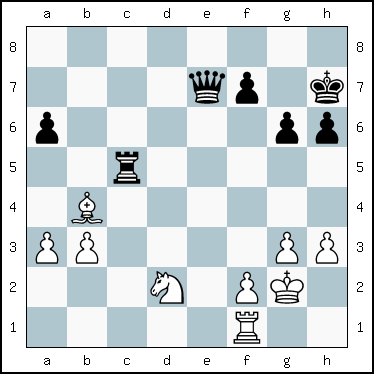

Black to move. The answer is on the next page.

1. ...  b7+ An intermediate move. The Queen moves out of the diagonal with check,
and the pinned Rook escapes on next move.
b7+ An intermediate move. The Queen moves out of the diagonal with check,
and the pinned Rook escapes on next move.
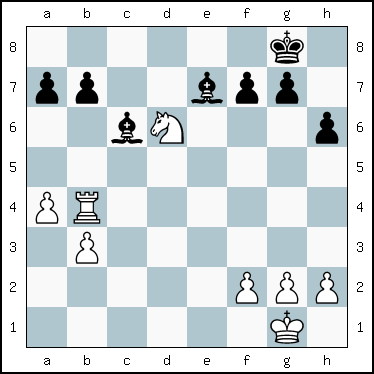
1.  d4 The attacked piece moves to defend the pinned piece.
d4 The attacked piece moves to defend the pinned piece.
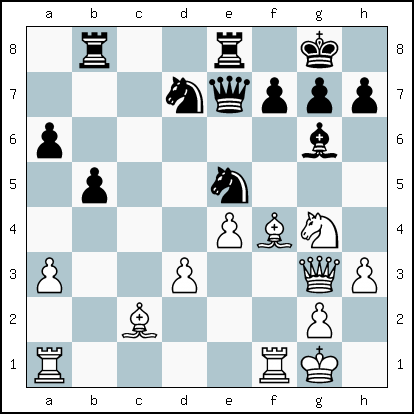
Black to move. The answer is on the next page.

1. ...  c8 The attacked piece moves to attack an opponent's undefended piece, the Bishop on c2.
c8 The attacked piece moves to attack an opponent's undefended piece, the Bishop on c2.

1. ...  xg4 2.
xg4 2.  xb8
xb8  c5+ 3.
c5+ 3.  h1
h1  xb8 4.
xb8 4.  xg4
xg4  xc2
xc2
The pinned piece moves capturing a piece, the target is captured, and a double attack with check follows.
This definition includes different Patterns, which have in common the fact that the pin is not real:
the pinned piece can unpin, winning material or preparing a trap, where the material lost can be great.
In the first case many times a player is not aware of the error he did, and the opponent is not aware that he can
take advantage of that.
In the second case instead, the trap is prepared, and if the opponent does not fall in it, the resulting position can be favorable.
The unpinning can be the starting move of the sequence.
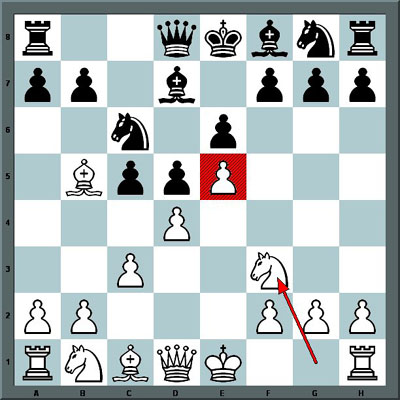
C00 French defense
1. e4 e6 2. d4 d5 3. e5 c5 4. c3  c6 5.
c6 5.  b5 pins
b5 pins  d7 unpins 6.
d7 unpins 6.  f3 ?
f3 ?
A similar error occurs frequently in this variant of French defense, and many black players
do not realize it. The Knight  f3 does not protect anything.
f3 does not protect anything.
As Bishop Bb5 is not protected, and it is attacked once by the Bishop d7 through the Knight c6 (X-Ray).
The Knight c6, by capturing on e5 can recapture in d6 if so needed.
Is this evident? No?
Black can unpunished move the Knight  c6, with an appropriate double attack.
And anyway it can capture appropriately and with no danger anything located on e5: it is a strategic square as it defends
d7, where it can come back if the d7-Bishop is captured.
c6, with an appropriate double attack.
And anyway it can capture appropriately and with no danger anything located on e5: it is a strategic square as it defends
d7, where it can come back if the d7-Bishop is captured.
6. ...  xe5! a possible continuation:
xe5! a possible continuation:
7.  xd7
xd7  xd7 with a net gain for Black of one pawn
xd7 with a net gain for Black of one pawn
Always consider that the right sequence of recapture must be considered, you are non obliged to recapture with the piece directly threatened, in the above case the King. A frequent evaluation error.
As if:
7. ...  xd7 (or
xd7 (or  xd7)
xd7)
then
8.  xe5 and Black loses a knight for a pawn.
xe5 and Black loses a knight for a pawn.
If instead the Knight on e5 is captured, then the unprotected Bishop is recaptured:
 xe5
xe5  xb5 with a net gain for Black of one pawn.
xb5 with a net gain for Black of one pawn.
The reason being the insufficient knowledge of this pattern.
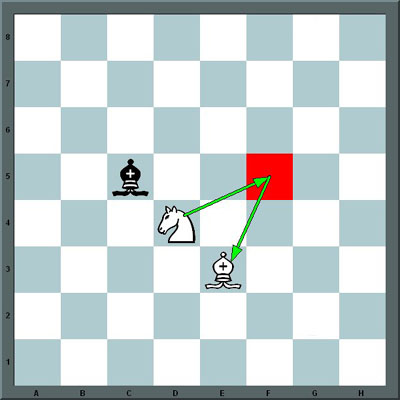
the Pattern to remember
The features are the usual Knight, pinned (?) by an opponent's Bishop, and protected by his own Bishop. This latter must be protected in some way. The opponent's Bishop must, through an X-ray attack, be attacked one time more than the protection. On the square where the Knight can go (marked in red if you have a color display) to come back to the square of his own Bishop there must be something to capture. Winning one pawn or one piece.
Illusory pin or phantom pin. Also called The Elastic Band Knight or The rubber band
(the knight runs out and grabs a pawn, then twangs back before it can be recaptured).
The pattern shown is common to many situations where the knight is not really pinned, but can move, capture,
and recapture as indicated by arrows.
A way to unpin, capturing any piece located on f5 or c2:
1.  f5
f5  xe3
xe3
2.  xe3
xe3
The net result being what captured on f5, usually a pawn or a Knight.
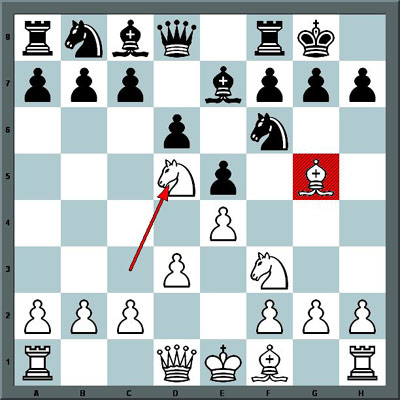
C42 Petroff defense
1. e4 e5 2.  f3
f3  f6 3.
f6 3.  c3 d6 4. d3
c3 d6 4. d3  e7 5.
e7 5.  g5 ? O-O 6.
g5 ? O-O 6.  d5 ?
d5 ?
Actually, after  g5 Knight
g5 Knight  f6 in not pinned, as it can move freely
with no consequence.
f6 in not pinned, as it can move freely
with no consequence.
And Bishop  g5 is in a dangerous position, as it is only apparently
protected (once), while it is attacked twice (x ray) through the Knight
g5 is in a dangerous position, as it is only apparently
protected (once), while it is attacked twice (x ray) through the Knight  f6:
it can be one target of a double attack.
f6:
it can be one target of a double attack.
Move  d5 is a mistake, it could be an outpost if black pawn were in c5
instead than in c7, and the light-squared Bishops were exchanged, here it could be
driven away by the pawn or the Bishop. The threat of a series of exchanges on f6 is meaningless.
d5 is a mistake, it could be an outpost if black pawn were in c5
instead than in c7, and the light-squared Bishops were exchanged, here it could be
driven away by the pawn or the Bishop. The threat of a series of exchanges on f6 is meaningless.
White is going to lose one piece.
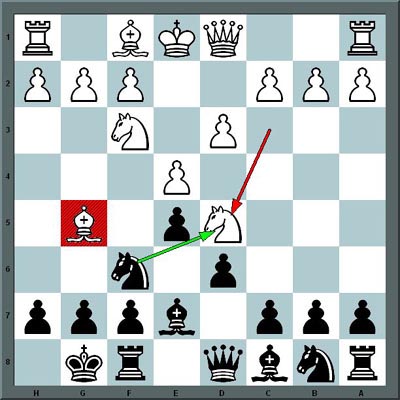
Viewed the other side around, from Black side
Clear? Isn't it?.
Black can without danger break the pin and play Knight  f6, with a well timed double attack.
And anyway he can take advantageously and without any danger anything located on d5:
a strategic square, as it also defends e7, where he can go back if the Bishop is captured.
f6, with a well timed double attack.
And anyway he can take advantageously and without any danger anything located on d5:
a strategic square, as it also defends e7, where he can go back if the Bishop is captured.
 xd5! A possible continuation:
xd5! A possible continuation:
 xe7
xe7  xe7 ending a full Knight up.
xe7 ending a full Knight up.
exd5  xd5 that cannot be recaptured, ending a full Bishop up.
xd5 that cannot be recaptured, ending a full Bishop up.
Obviously avoid in this second case the error of recapturing with the Queen
 xe7??, as exd5 will follow, giving back the Knight.
xe7??, as exd5 will follow, giving back the Knight.
It's wise to always chose the right captures sequences, it's not mandatory to recapture with the piece
directly threaten. A frequent evaluation error (named "counting error" by Heisman).
You can play through sample games and download the PGN here: Phantom pin http://scacchi.vecchilibri.eu/partite/phantom.html and here Knight's triangle http://scacchi.vecchilibri.eu/partite/knightstriangle.html
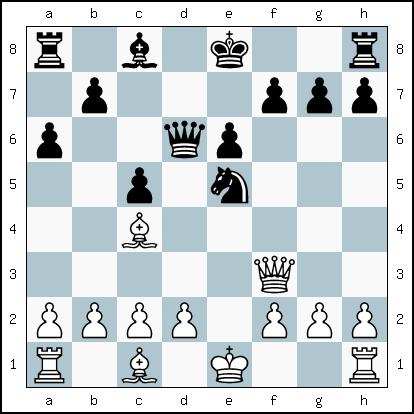
similar Pattern
FEN = r1b1k2r/1p3ppp/p2qp3/2p1n3/2B5/5Q2/PPPP1PPP/R1B1K2R w KQkq - 0 13
13.  g3? The Knight is pinned against the Queen. However the Knight can unpin capturing on c4, protecting the Queen at the same time
g3? The Knight is pinned against the Queen. However the Knight can unpin capturing on c4, protecting the Queen at the same time  xc4 !
xc4 !
Potete vedere questa e qualche partita di esempio e scaricare il pgn su: Unpinning http://scacchi.vecchilibri.eu/partite/unpinning.html . More than 20 examples.
Questa lezione è tratta dall'ebook disponibile su Amazon Learn how to unpin, che illustra completamente i metodi per schiodarsi, con vantaggio. http://www.amazon.it/dp//B0741XZG33